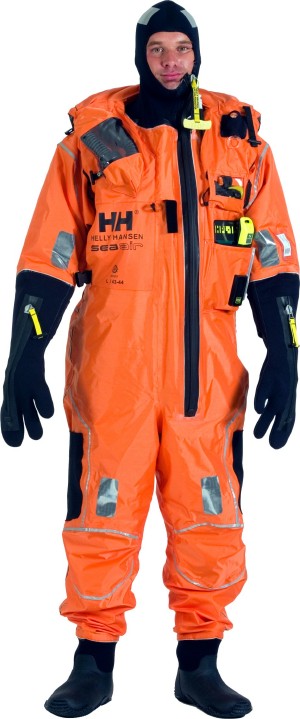Oct 16 2008
The country's most elaborate travel-wear keeps the body cool in hot helicopter cabins, but transforms into a heat-retaining suit if the helicopter should fall into the sea.
 The new helicopter suit cools the body in the hot helicopter cabin, but it will also help offshore platform personnel on the Norwegian continental shelf to survive should an accident occur and they fall into the sea. (Photo: Helly Hansen)
The new helicopter suit cools the body in the hot helicopter cabin, but it will also help offshore platform personnel on the Norwegian continental shelf to survive should an accident occur and they fall into the sea. (Photo: Helly Hansen)
We are in one of SINTEFs laboratory basins. The demonstration of the helicopter survival suit only takes a few minutes. The test person crawls out of the pool and changes into dry clothes.
Completely different rules apply during scientific trials: six hours without consuming food or drink, in a horizontal position in water at a temperature of two degrees Celsius with a strong breeze from a wind machine hitting you straight in the face. All this is necessary in order to create suitably realistic conditions.
Exploiting the properties
Materials have always been of great significance to humans. In earlier times, materials only had a support function. Wood, steel and iron were mostly used for building and construction. Today’s materials are of a different calibre, containing the addition of special properties, mainly electrical, optical, magnetic and chemical. Instead of using them for construction purposes, we equip them with properties that provide increased strength, better safeguarding against rust, repelling of graffiti or the ability to store or emit heat. The modern functional materials have forms such as membranes, catalysts, thin films, semiconductors and sensors.
“This is about exploiting, adjusting and adding new properties to the materials,” says Research Director Jostein Mårdalen at SINTEF. “Today we have the knowledge to develop materials in an intelligent manner with a minimum of trial and error.”
Intelligent materials
Smart materials provide us many opportunities. At the Department of Work Physiology at SINTEF, Tore Christian B. Storholmen is hard at work. He designed the helmet concept ProActive and recently received an award from the Norwegian Design Council. He displays the white helmet and explains why it is so smart.
“The helmet is lined on the inside with a material called d3o made with intelligent molecules. These flow freely as long as they are not subjected to pressure, but the second they receive a blow or impact they lock together. The material’s soft and flexible normal condition instantly locks and become hard and shock-absorbent,” says Storholmen, adding: “When the shock after the impact diminishes, the molecules unlock and become flexible again.”
The d3o material does not harden when it is subjected to impact, but the effect is comparable with a net that absorbs and distributes the force.
The helmet is shaped like a baseball cap. Parts of the helmet prototype are transparent to enable people to observe the d3o material. The properties of d3o make it ideal for protecting the body, and it can be beneficial for sportspeople and those working in vulnerable conditions.
“I have a brother who works in the building and construction industry and he told me that many people find protective helmets uncomfortable,” says Storholmen. “I wanted to make a helmet that was good to wear and also offered the necessary protection.”
The intelligent material d3o is also used to provide knee protection in children’s overalls, snowboarders’ hats, football shin pads and protective equipment for motorcyclists.
Smart functions
“We are becoming increasingly better at exploiting material properties because our basic understanding of material properties is increasing,” says Mårdalen. “We are also gaining increasingly more advanced analytical tools to study materials at the nano-level. Possibly the most important contribution is that we can now design materials on a nanometer scale.”
Chemists and physicists have for a good many years studied materials at nano-level, but have been unable to build with sufficient precision at submicro level. Scientists have now come so far that they are in a position to construct and manipulate at atom level with sufficient precision. This is one of the main reasons why nanotechnology is now gathering speed.
“This knowledge gives us the possibility to customise materials and surfaces so they gain the properties we want,” says Mårdalen.